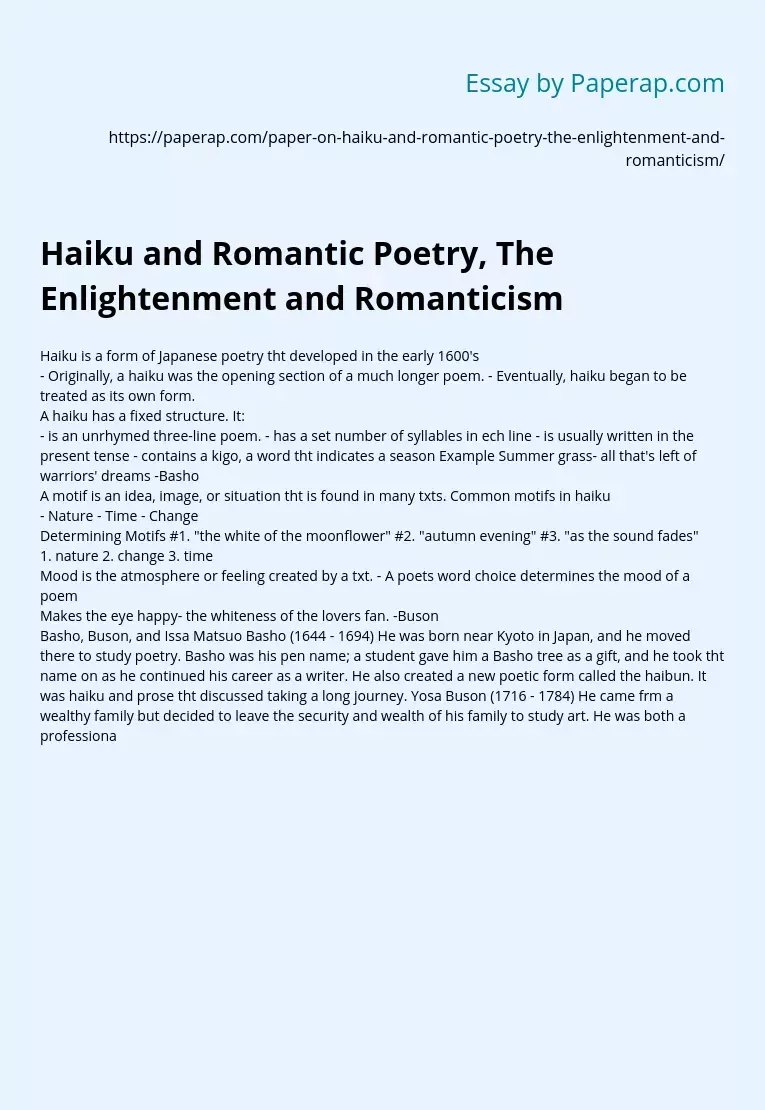Haiku and Romantic Poetry, The Enlightenment and Romanticism
– Eventually, haiku began to be treated as its own form.
– has a set number of syllables in ech line
– is usually written in the present tense
– contains a kigo, a word tht indicates a season
Example
Summer grass-
all that’s left
of warriors’ dreams
-Basho
Common motifs in haiku
– Time
– Change
#1. “the white of the moonflower”
#2. “autumn evening”
#3. “as the sound fades”
2. change
3. time
– A poets word choice determines the mood of a poem
the whiteness
of the lovers fan.
-Buson
Matsuo Basho (1644 – 1694)
He was born near Kyoto in Japan, and he moved there to study poetry.
Basho was his pen name; a student gave him a Basho tree as a gift, and he took tht name on as he continued his career as a writer.
He also created a new poetic form called the haibun.
It was haiku and prose tht discussed taking a long journey.
Yosa Buson (1716 – 1784)
He came frm a wealthy family but decided to leave the security and wealth of his family to study art.
He was both a professional painter and a poet.
He studied and promotd the work of Basho.
Kobayashi Issa (1763 – 1828)
He was the son of a farmer.
And at the young age of 14 he went to Edo; which is modern-day Tokyo, to study haiku.
Isa is his pen name.
Read the haiku by Bashō.
The crane’s legs
have gotten shorter
in the spring rain.
What motif is presented in the poem?
A crow
has settled on a bare branch—
autumn evening.
What is the kigo in this haiku?
Beneath the cold dirt
Bulbs slumber with the knowledge
Shoots emerge again
Which phrase from the haiku reveals the idea of renewal?
“Haiku by Basho” & an excerpt from “Repentance by William Wrdsworth”
What motif is addressed in both forms of poetry?
Read these poems.
“Haiku by Buson” & an excerpt frm “Wine of the Fairies by Percy Bysshe Shelley”
What motif is addressed in both forms of poetry?
Many flowers bloom
But no fruit follows in time
Bare vines remain.
Which word reveals the idea of disappointment?
C.
Each tree in the yard
Announces its vigor
With buds on each branch.
What is the kigo in this haiku?
Japanese haiku are similar to English romantic poems because they both
D.
The poem’s mood is best described as its ____________.
Read the haiku by Bashō.
Midnight frost—
I’d borrow
the scarecrow’s shirt.
What is the mood of the poem?
Awake at night,
the lamp low,
the oil freezing.
The carefully selected words in this haiku create a
Haiku and Romantic Poetry, The Enlightenment and Romanticism. (2018, Jan 18). Retrieved from https://paperap.com/paper-on-haiku-and-romantic-poetry-the-enlightenment-and-romanticism/

